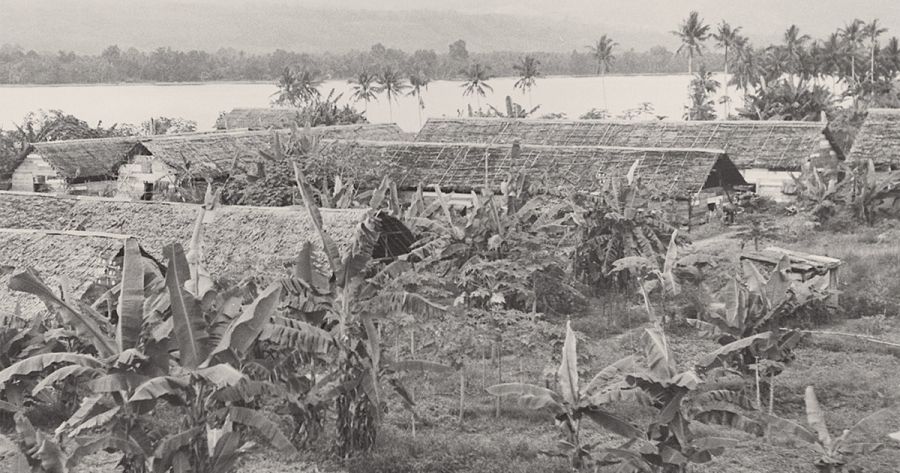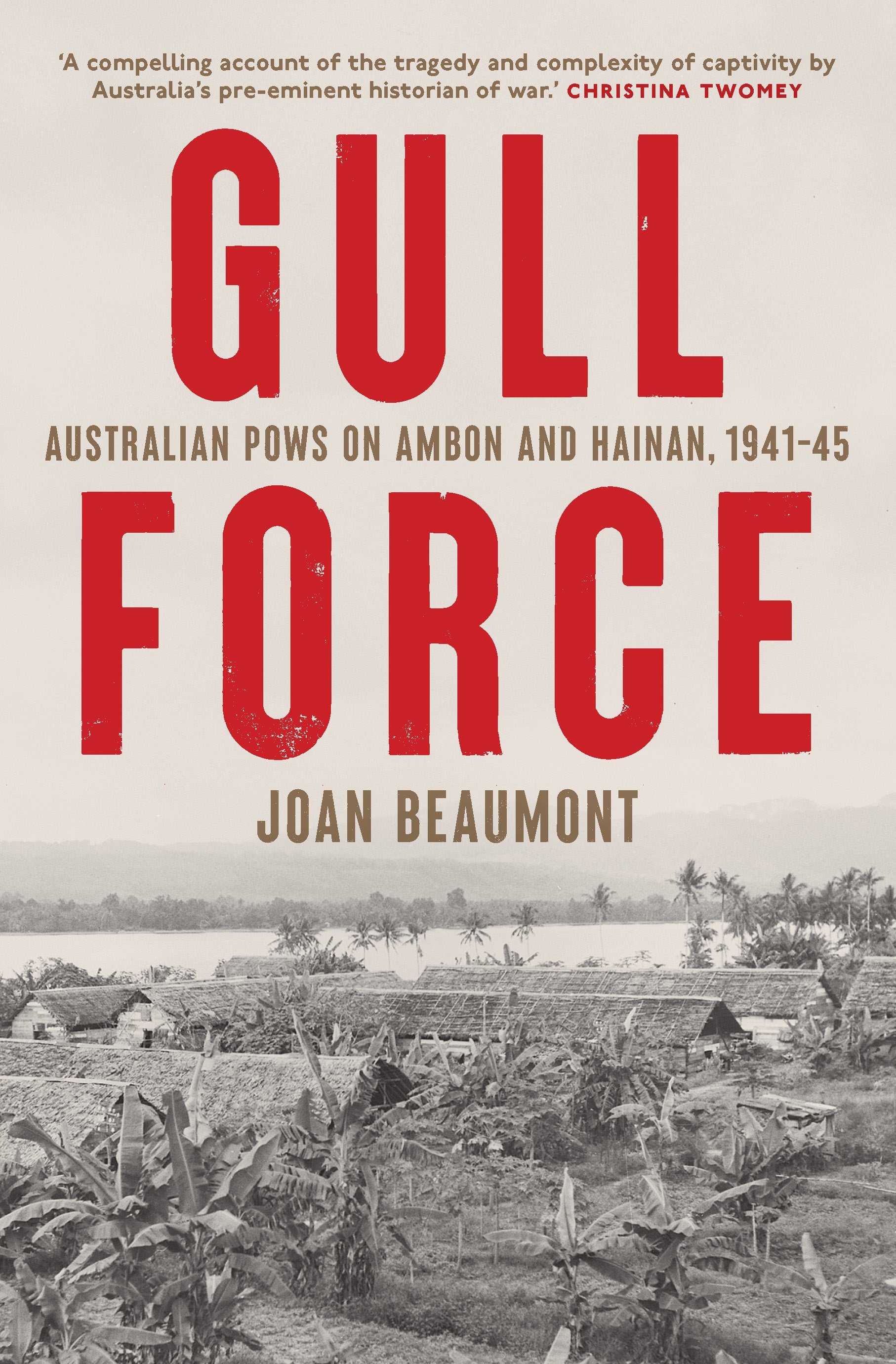
- Free Article: No
- Contents Category: Military History
- Review Article: Yes
- Article Title: Gull Force revisited
- Article Subtitle: A good book made better
- Online Only: No
- Custom Highlight Text:
This is a sombre, sad, and at times angry book. It is also a wise book. The sister of one of those Australian prisoners of war in World War II who died at Ambon wrote: ‘Everyone who was touched by Ambon has a crying heart which will never leave them.’ Of an initial force, since known as Gull Force, of 1,131 men, 779 were killed in action or died as prisoners. There were many crying hearts in Australia.
- Book 1 Title: Gull Force
- Book 1 Subtitle: Australian POWs on Ambon and Hainan, 1941-45
- Book 1 Biblio: Second Edition, NewSouth, $39.99 pb, 431 pp
- Book 1 Cover Small (400 x 600):

- Book 1 Cover (800 x 1200):

- Book 1 Readings Link: https://www.readings.com.au/product/9781761170027/gull-force--joan-beaumont--2025--9781761170027#rac:jokjjzr6ly9m
In December 1941 the commander of the 2/21st Battalion Australian Imperial Force, Lieutenant-Colonel L.N. Roach, advised AIF headquarters in Melbourne that it was impossible to prevent Japanese landings on the island, soon expected, and that his men should all be evacuated. Roach was instantly dismissed and recalled to Melbourne to be replaced by fifty-three-year-old Lieutenant-Colonel W.J.R. Scott, on appointment the oldest battalion commander in the 2nd AIF. In Gull Force, Beaumont is clearly angered by the stupidity of every decision about Ambon made by Melbourne AIF headquarters during this war.
And wise? Of Scott’s failure of leadership on Ambon, Beaumont writes: ‘Leadership [in the military] is inherently situational … there was no template as to how officers trained to command in battle should lead in captivity.’ The normal sanctions employed by officers to enforce discipline are not available to the commander of prisoners of war, himself a captive. Among Scott’s many failures was his decision to hand over Australian prisoners to the Japanese for punishment for infringements of the Australian military code. This resulted in the appallingly savage beating and torture of Australians well beyond what might have otherwise been meted out for their crimes or misdemeanours. The men hated Scott.
Beaumont gives readers asides throughout, drawing on her wealth of experience. One such: ‘Many struggled to achieve what is now popularly called “closure”. If such a state is possible – and on that a hefty scepticism is surely warranted.’ Beaumont writes history with ‘hefty scepticism’, gifting her writing a believability, salted with understanding and quiet humour. This somewhat relieves the awful tale she has to tell.
The 2/21st Battalion AIF, recruited largely in Victoria and trained mostly in Darwin, arrived on the island of Ambon, now part of Indonesia, in early 1942, without adequate equipment, guns, ammunition or air cover, to fight on a terrain that rose to steep heights, fell to deep valleys, and contained uncrossable rivers, with few roads and often impenetrable jungle. The prospects were forlorn. Losing a commander who had been with his battalion since its formation in May 1940, had supervised its training, knew intimately its strengths and weaknesses, and was well-liked and respected, for a leader nobody knew, added to the battalion’s woes.
How had Jack Scott come to be selected? At Melbourne headquarters, where he worked since June 1940, he inexplicably volunteered to take over the battalion. A survivor of World War I, he was a right-wing, authoritarian leader who had been a member of the paramilitary groups self-designated to ‘save’ Australia from legitimately elected governments, including the New Guard and the King and Empire Alliance. Scott was probably also suffering from World War I trauma. He arrived on Ambon a stranger to the battalion, with deep prejudices against it, without any knowledge of the terrain over which his battalion would be fighting, and without a battle plan. Every member of the battalion would have surmised that this would not end well.
Some units saw no fighting at all, some engaged the enemy for at most a day, some fought on a little longer. All were doomed. Soon after capture in February 1942 the Japanese divided Gull Force into two sections; a portion remained on Ambon, the remainder were sent to the island of Hainan, now part of China. During these early months of 1942, fifty-four men of the battalion died in battle and 229 were massacred at Ambon’s Laha airfield. Subsequently, seventeen prisoners of war were executed at the camp at Ambon, thirteen were killed by Allied bombing, an additional 378 died as prisoners of war in Ambon, and sixty-six died at the camp at Hainan. Other deaths from a miscellany of incidents brought the total number who died in captivity to 779.
This book was first published in 1988 under the title Gull Force: Survival and Leadership in Captivity 1941-1945. The text of the current book is largely unaltered but an additional section, ‘Aftermath’, is included. This section makes the book much richer and more nuanced. Commencing with ‘Justice and Burials’, Beaumont discusses the Australian war crimes trials held at Morotai and Hong Kong between 1945 and 1951 relating to Ambon and Hainan.
Always striving to be fair, Beaumont considers the challenges that the former Japanese officers faced in these trials, including language problems, an unfamiliarity with Australian court procedure, and the fact that the Australian witnesses often only knew the nicknames of their Japanese guards. She considers whether the trials accorded justice to the accused, finding that on balance they did.
Beaumont also discusses difficulties in creating war cemeteries that are accessible and able to be managed, noting that the Australian government’s decision to create a war cemetery at Yokohama in Japan angered some Australian survivors and their families who believed that their war dead would not wish to be buried in enemy territory. The decision went ahead with Yokohama remaining to this day a major Commonwealth war cemetery.
Beaumont turns to what she calls ‘Living with Memory’, addressing the response of survivors to the new world they found on their return to Australia. They discovered that things were different. This may seem obvious but is actually not. In their dreams about home while they were held in captivity, the people they left behind remained exactly as they were. But younger siblings who might have been quite small four years ago had grown to be near adults. A mother who was remembered as middle-aged became an old woman under the strain of her son’s absence. Fathers discovered that their children were accustomed to asking their mothers for consent and advice and that the children were reluctant to change the order of things. Marriages needed to be carefully renewed, courting for engaged couples restarted.
As Beaumont recognises, there was no template to manage this complex set of issues. Each returning prisoner needed to respond to his unique circumstances. Nor was there any way of predicting, from the variety of factors at play, who would succeed and who would remain evidently damaged. This chapter goes to the core of the prisoner of war experience; Beaumont handles it with skill, understanding, and perceptiveness.
In a final, short chapter, ‘Gull Force in National Memory’, Beaumont suggests that the Gull Force experience should not be reduced to a ‘traditionally morally uncomplicated battle between Australians and their enemy’. This updated edition of Gull Force reveals a much more complex story and finally offers a necessary, important, and thorough examination of what that story means.
It is often claimed that historians get better as they get older. As a senior historian, Joan Beaumont allows the reader to see how a good book, published thirty-seven years ago, can with time be made even better.


Comments powered by CComment